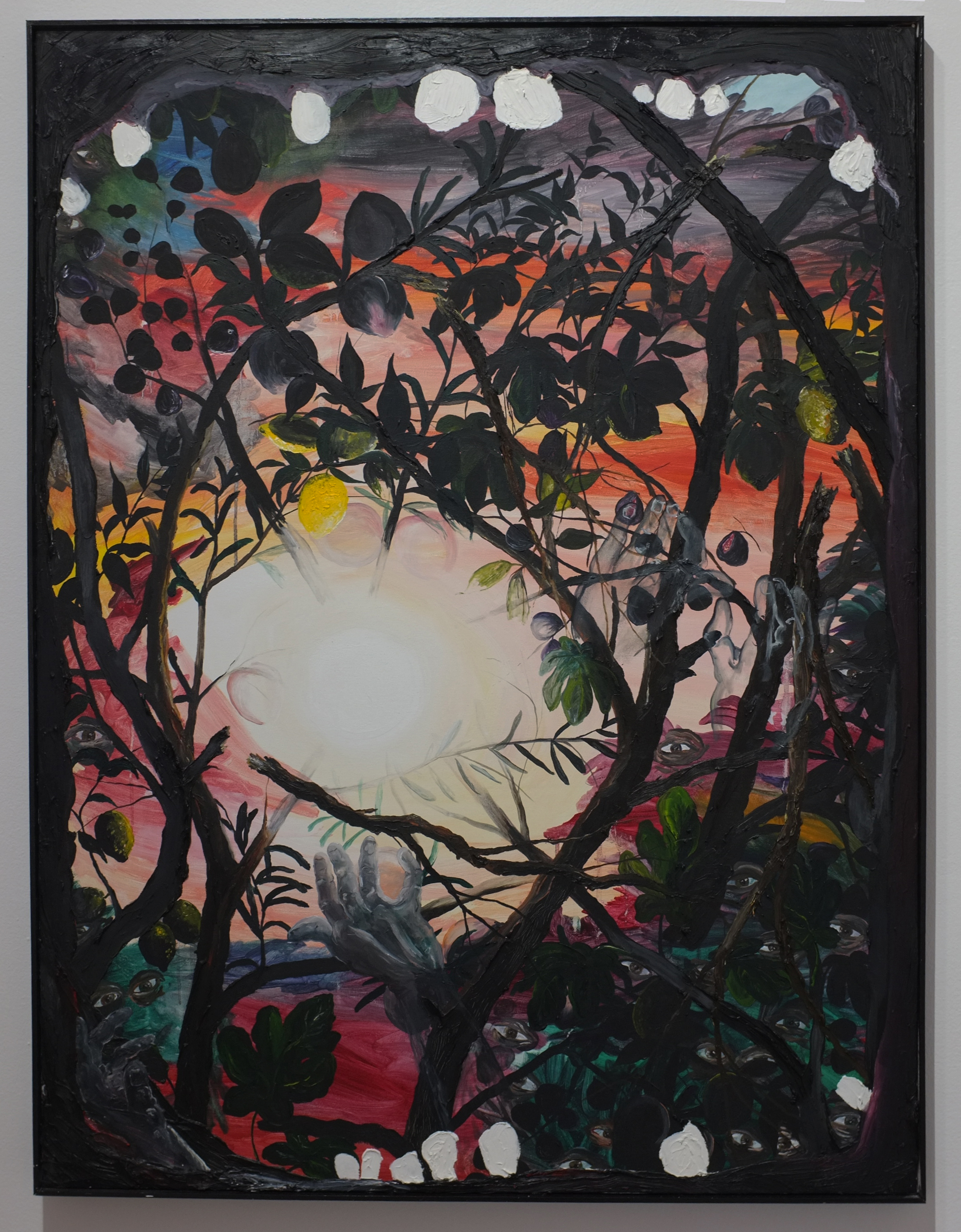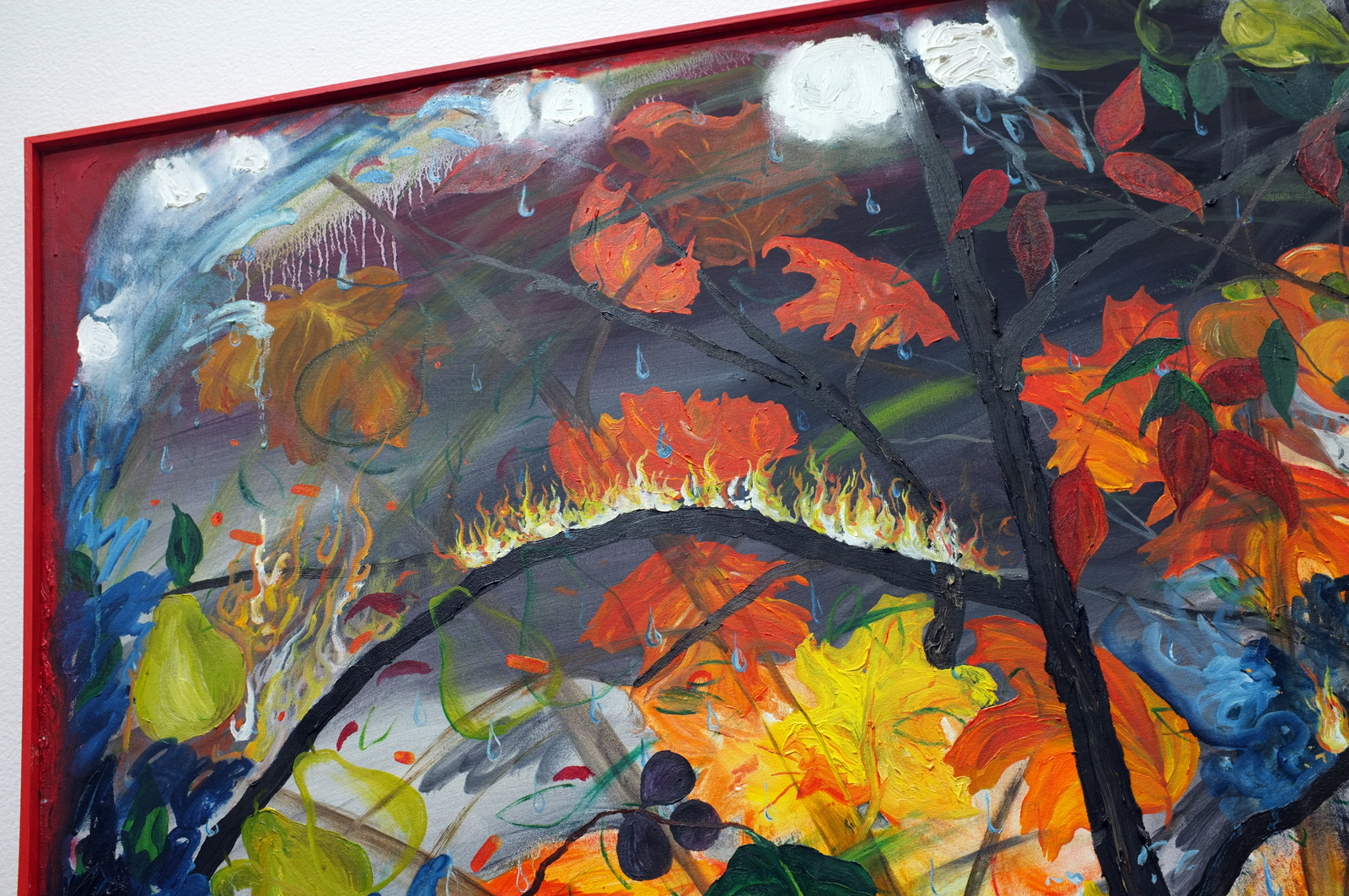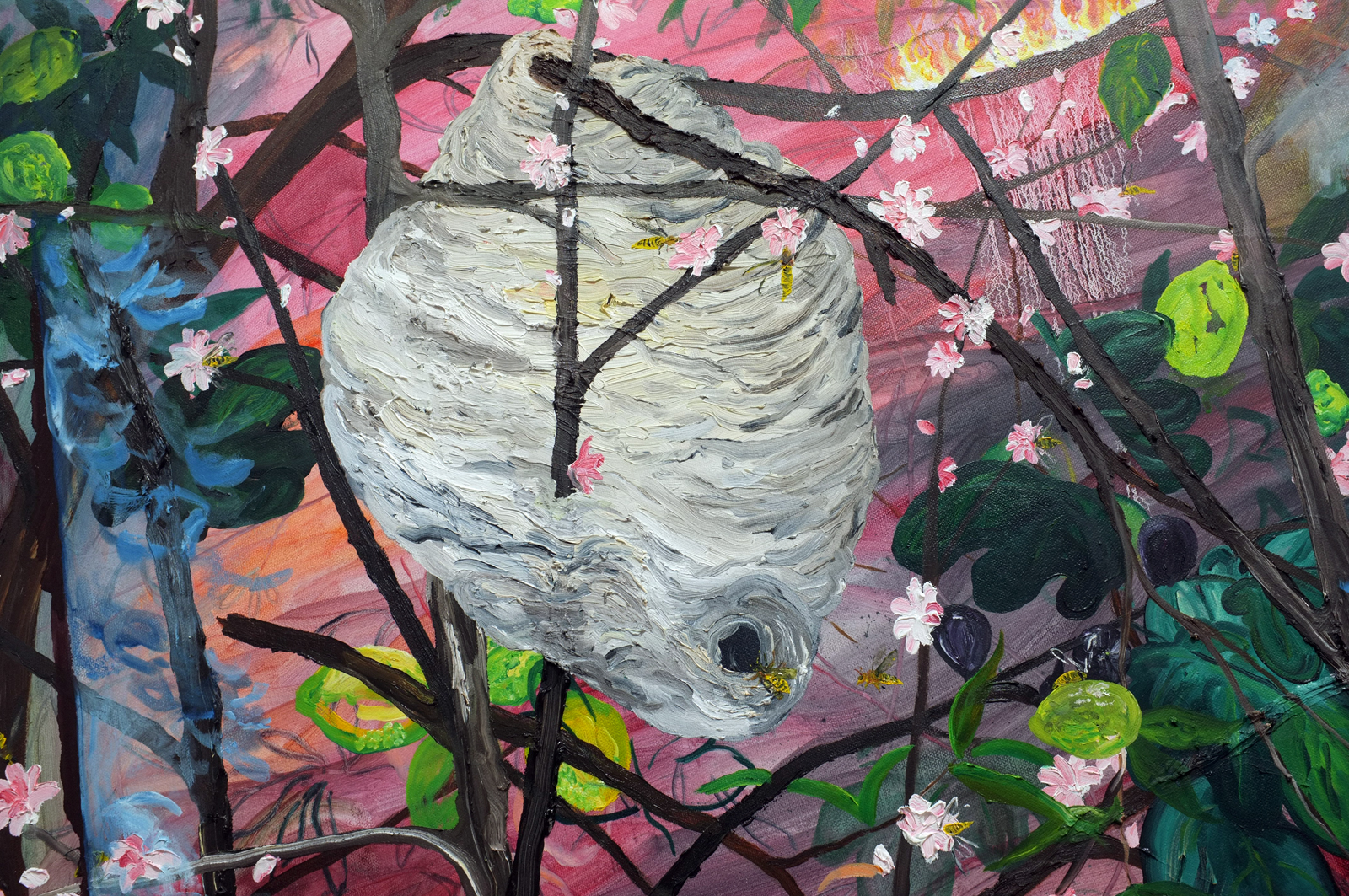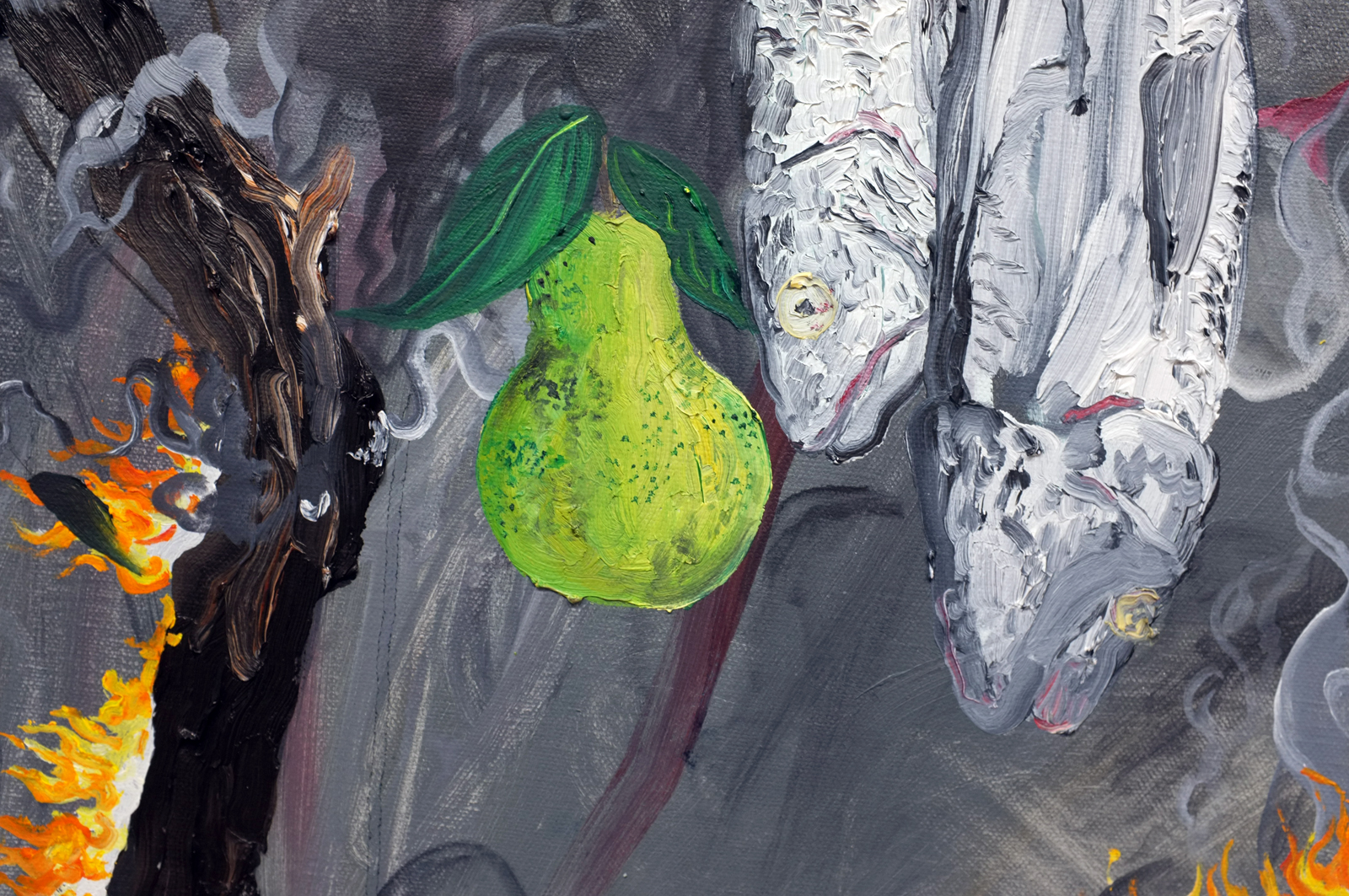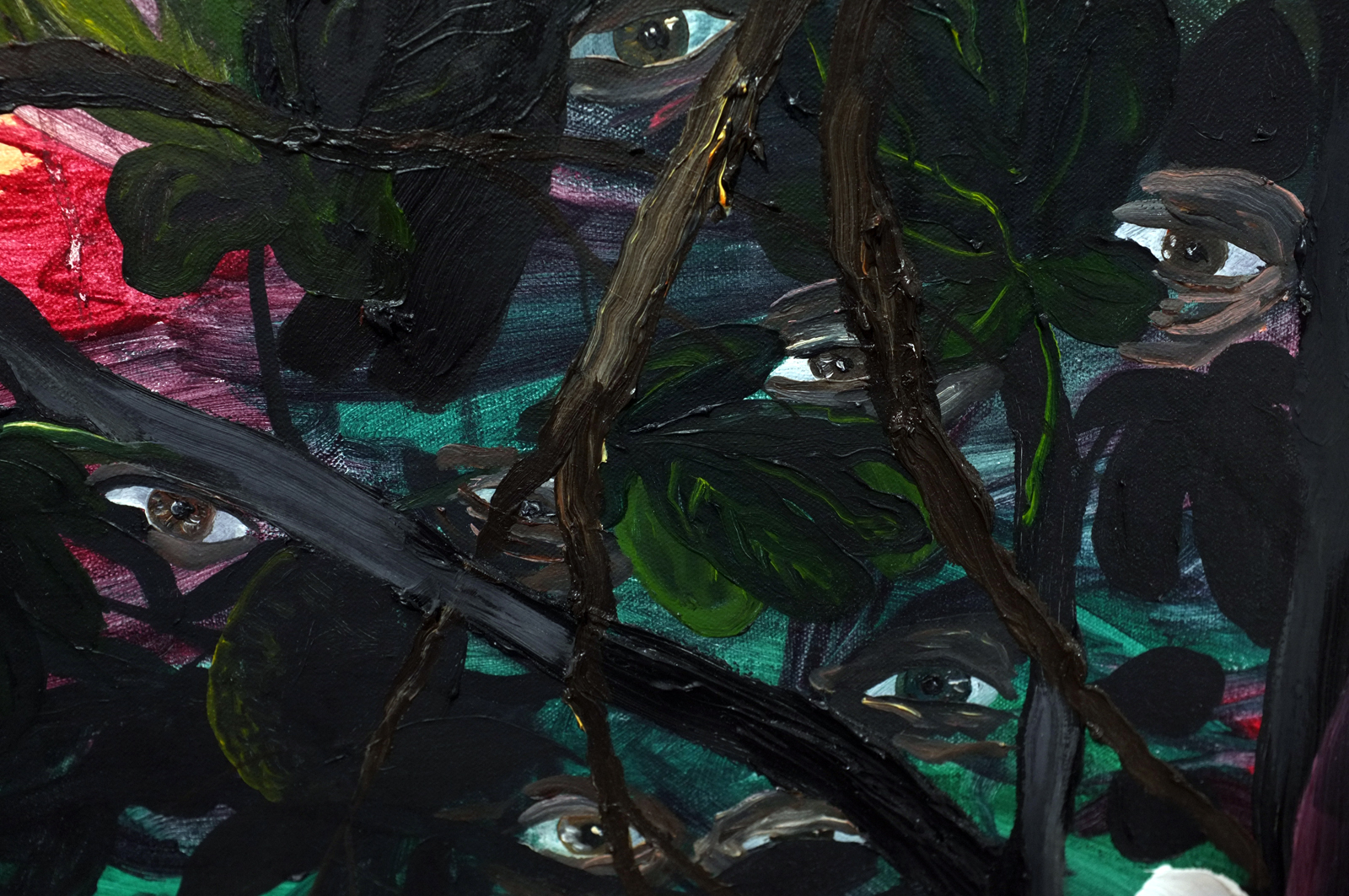text and photographs by Summer Bowie
Are you staring directly into the mouth of the beast, or are you indeed sitting inside said mouth, observing the surreal landscape below? This is just one of the many visual homonyms that are ever-present in the works of Morgan Mandalay. For his first solo exhibition at Klowden Mann in Los Angeles, the Chicago-based artist has painted worlds that are rife with reference to human figuration, though only vaguely, in the form of phantom hands clutching at tree branches, or humanoid eyeballs peeking through leaves. Traces of our existence are evident in the still life formations of pitted fruits, or in fish hung by twine, and most conspicuously in the presence of a large brick wall. Otherwise, these worlds seem to be inhabited by fruit and flora that rot and burn on the vine, trees that seem to bear both lemons and pears simultaneously; a world where omniscient angels are standing by for either the sake of protection and salvation, or eternal damnation. Bad Sin Frutas tells a story of exile using the memetic power of the Garden of Eden as a template for processing the Mandalay family’s exile from Cuba, and it does so in a time of global refugee crises. As far as its temporal grounding, Morgan sighs with a reticence to use the term “post Anthropic” when he points to what this world might be gesturing towards. The mild humiliation on his part seems to come from two places. The first might be a feeling of sounding trite, knowing that the post Anthropocene is a well-explored subject in contemporary art. The second might be that he and I have known each other since we were teenagers in San Diego, or perhaps, we only know each other as teenagers, and having only recently reconnected, he knows this is a term that our teenage selves would find grossly didactic. To me, it seems a perfect paradox for this parallel universe we seem to be inhabiting where the past is constantly colliding with the present, further perplexing our sense of the future. I got a chance to preview the show with Morgan and talk about his perpetual use of quizzical homonyms, his nomadic life as an artist, and the interdependent qualities of one’s creative and administrative efforts.
SUMMER BOWIE: Let’s just start with the title of the show, Bad Sin Frutas. Can you tell me a bit about it’s meaning? Is it Bad Sin [Spanish pronunciation] Frutas, or Bad Sin [English pronunciation] Frutas?
MANDALAY: (laughs) Yeah, I mean that’s it. Well, my titles are generally a play on language and scrambling language, or a play with the mutability of meaning, as an extension of understanding a fluid self. Language, in whatever form, be it written, spoken, painted or whatever, as a kind of marker of self. "Norman Amygdala" was an anagram of my name, "Scene of Shipwreck", "Thank you squash banana. I'm not an ape, you are"…they’re all plays on homonym or mistranslation. Originally I’d been thinking the show should be called “Sin Frutas,” but I was also toying with “Bad.” My partner (Kim-Anh Schreiber) is who suggested the merger and I think it was way more effective. Bad Sin Frutas.
BOWIE: You have a multi-pupiled demon that started showing up in your work in 2017, in this series of works they appear but are hidden in lean layers, can you tell me a bit about where that came from?
MANDALAY: Right, the cherubim. They come from the book of Ezekiel and they appear to be demons, but they’re actually angels who guard the gates to the Garden of Eden with a flaming sword. They’re described as having multiple faces, and the multiple pupils convey the motion of their eyes, which are all-seeing, and constantly observing and judging and protecting.
BOWIE: So, they were basically like the Biblical Big Brother? (laughs) When you say cherubim, the image in my mind is that of a bored, chubby baby.
MANDALAY: Well, yeah we have a very diluted idea of angels nowadays, but in the order of angels there are cherubim, seraphim, the throne, archangels, and four others. The seraphim are usually depicted with six wings and the cherubim have four wings. They all have different purposes that they serve, and were we to have grown up in Europe during the Middle Ages, we would more likely be familiar with the types of angels represented in these Biblical paintings, and the roles that they play in the Bible. However, we grew up on Touched By An Angel, and City of Angels, and Michael, and Angels in the Outfield, so at this point most of us are imagining someone sexy with washboard abs or, yeah, the like…Rococo fat Cupid baby.
BOWIE: Can you talk about Géricault’s “The Raft of the Medusa” and how that fits into your work?
MANDALAY: Sure thing. I think I alluded to my interest in homonym before––a thing that looks like one thing and means another, or can hold two meanings at once. Lots of people seem very certain in their beliefs, and part of those beliefs is that the opposing beliefs are certainly wrong. And hell, some things are wrong, of course. I’m not some extreme moral relativist but…some things can look like one thing and mean something else. “The Raft of the Medusa,” previously titled “Scene of Shipwreck,” is a painting that could be two events. It could be sunset or it could be sunrise because there’s nothing in the painting to tell us which direction we are pointed. The ship on the horizon, silhouetted, could be coming closer or going away. The people of the raft are either being saved, or they’re being left to die. It all depends on how much you know about an obscure piece of 18th century French history that at the time seemed important enough to be commemorated on a giant canvas, in basically Géricault’s only well-known painting, and then travelled around England.
BOWIE: And what about the role of still life in these works?
MANDALAY: Kind of the same answer. But also I like that still life painting was, and in many ways maybe still is, the “lesser-than” form of painting. When I started making still lifes I would do it with my leftover paints on my palette, or with the pigment sludge at the bottom of my turpentine jar. They’re….I don’t know, humble.
BOWIE: Sure. There’s definitely something to be said for Manny Farber’s “termite art” approach. After living, studying and working in San Diego, San Francisco, Portland, New York and Chicago, do you feel as though the dramatic change in settings/scenes has affected your work?
MANDALAY: Yes and no. I think not knowing what I am, or stability has definitely shaped my work. I think my work often doesn’t know what it is. My paintings, I hope, are always similarly trying to locate themselves, or asking the viewer to join in that attempt.
More directly I can say, I’ve certainly picked up nuggets along the way or been affected differently by where I was. San Diego is my home and everything I guess stems from there. In San Francisco, I think I always go back to studying with Keith Boadwee specifically as formative. When I dropped out of SFAI and moved to Portland, that’s where I guess I really dove into paintings as my primary mode of making, and then spent the next 5 years learning more about that in San Diego. Somewhere between San Diego and Chicago probably taught me everything about being a part of a community of artists, and running a space as a way I enjoyed being a community member.
BOWIE: That’s right. You went back to San Diego and opened your own gallery, SPF 15. Can you talk about the intention behind that gallery?
MANDALAY: I wanted to have a space that spoke to the locality. In terms of programming, I wanted to create a program that would bring people to San Diego, and show artists from San Diego alongside these other artists that are doing interesting things. Obviously, I benefit from that as well. I wanted to be able to be in San Diego, and be an artist, and not disappear. There was a talk that Tyson Reeder gave when I was living in Chicago. I often would harken back to on this—talking about all the projects that he and his brother Scott did in Milwaukee in the early 2000s. Really before the easy access of Instagram, it was a way of being visible, doing these projects and inviting people to this city that they potentially aren’t thinking of as an “art city,” but one that has abundant resources. To me, that was part of it too, he referred to it as a telephone line to the outside world. SPF15 was a telephone line to the outside world.
BOWIE: What does it stand for again? I remember you telling me once that the intention was to do exactly 15 exhibitions...
MANDALAY: It was Sunday Project For 15 exhibitions. We’ve done 14, so there’s still one to go. We did a few fairs and things like that too, but those don’t count as proper, nomadic beach exhibitions.
BOWIE: Do you think you’d ever like to go back to curating and running a gallery space?
MANDALAY: Yeah, I think about it a lot. To me it’s a part of being in a community. It’s really hard for me to separate that from my overall practice, or I don’t know, personhood.
BOWIE: Was it ever weird, switching hats from being the artist to the dealer?
MANDALAY: No, it should be weird, but as an artist, one of the things I get to do is make decisions about what I want to see in the world, and as a gallerist or curator, that’s part of what I’m doing too. Hopefully, creating thoughtful exhibitions, working with artists that I really believe in that add to the overall diversity of aesthetics, but also...that I want to see. Seeing is a big part of it. Both have these invisible administrative arms to them. Being an artist, there’s plenty of administrative work as well. I learned a lot about being an artist, in terms of the professional side of it, from being on the administrative side of running spaces. I don’t think of them as all that different. One hand washes the other.
BOWIE: What brought you back to Chicago?
MANDALAY: My partner is getting her PhD at Northwestern. It’s good…it’s cold. But our apartment is beautiful and my studio is next to our bedroom. And I’m working at a radical progressive studio here, Arts of Life, working with an amazing group of artists with developmental disabilities.
BOWIE: The color palette of this series of works feels very different from previous works, almost like Southern California after a massive fire. Can you talk about that?
MANDALAY: I live in Chicago now. I needed some color. No, for a while I’ve been making somewhat monochromatic paintings or just…darker. But I used to use a lot of color and I think I couldn’t tell if I was making good paintings or just pretty colored paintings so for a few years I thought I needed to strip them of candy sweet colors. But I feel really confident about these paintings. I’ve tried to deploy color meaningfully and more as a lure than as the fish.
BOWIE: I remember you being a drama kid in high school, how were you introduced to painting?
MANDALAY: It’s true! Oh my god, yeah. I don’t know if you remember this but I got to direct this one act that Neil and Serop, and I (to a lesser degree) wrote together called Schizophrenia. I think that had a really lasting impact on me. It really was like, the only art I did, and then I went to art school at SFAI. Which is its own long story.
It took me a long time to circle back to theater in my work. I think I was having a conversation with someone about the history of canvas, like, the material and realized that canvas had played this massive role, not just in art but in globalization (as sails), and theater as well, as traveling set pieces. Like, canvas is all about nomadism. I started imagining my paintings as stage flats and got to realize this in Italy with Kim-Anh Schreiber, my partner and amazing writer. We collaborated on a piece called “Meatloaf,” in which a ghost couple float from home to home for 500 years trying to decide what to make for dinner.
BOWIE: That’s hilarious. Do you see yourself branching out into other media at any point?
MANDALAY: Not really. I think the past few couple of shows, this one and the recent exhibition at BWSMX in Mexico City, are the first shows in a long while that were just rectangles hanging on walls. Pictures. And I quite liked those shows. Maybe I’m getting more boring, or maybe I’m getting a better idea of what I want, or I’m maybe just feeling more confident. Like, I love working with other people, but it’s been really nice to just trust that my paintings are doing enough heavy lifting all on their own, thank you very much. Ha.
BOWIE: What’s next?
MANDALAY: To quote a line from “Meatloaf,” “the future, the future, you’ll never be ready.”


